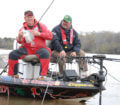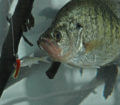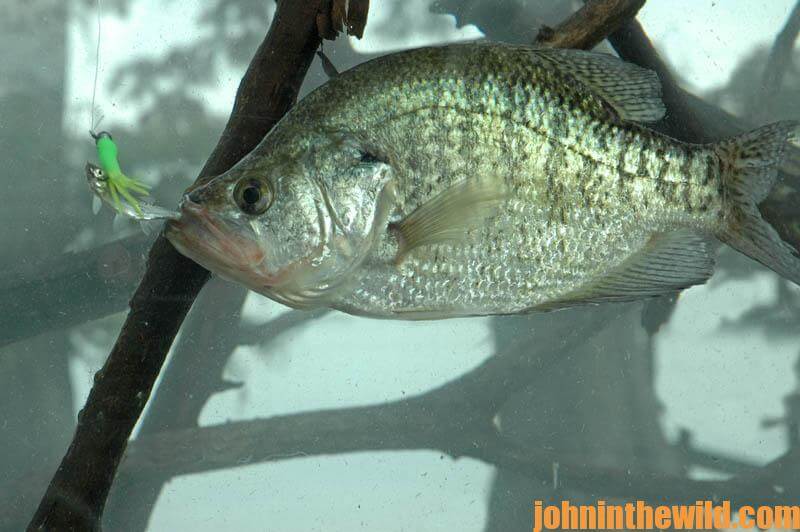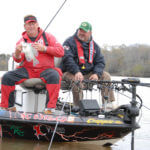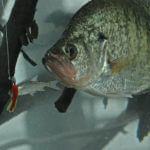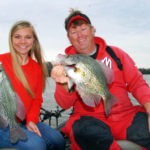Editor’s Note: Santa Claus has come down the chimney, and we’ve launched a new year. Most crappie fishermen have their poles rolled-up and stored under the porch, but not Whitey Outlaw of Gadsden, South Carolina. He fishes for crappie year-round and fishes on both crappie circuits, Crappie USA (https://www.crappieusa.com/About_Crappie_USA.cfm) and Crappie Masters (http://www.crappiemasters.net/home/). To help you catch papermouths this winter, we’ve asked Outlaw where he finds crappie and how he catches them.
There are many reasons that crappie fishermen don’t catch crappie in the wintertime. Here are the ten biggest reasons (Days 2 & 3) that I think most crappie fishermen don’t catch crappie in the winter, and what you can do to solve these problems.
6) You are not using your electronics enough. Your depth finder is your eyes under the water. Learn all you can about what it is telling you. Learn to experiment with it. Many times you will look at a depth finder and see it marking fish, stumps, logs or trash on the bottom. You’ll say to yourself, “I don’t believe that depth finder is telling me the truth.” So, investigate with your fishing tackle to try and learn exactly what that depth finder is telling you, and how the information you’re getting from that depth finder relates to your ability to catch crappie. Once you learn how to understand the information the depth finder is giving you, you will know what types of locations produce crappie, what a school of crappie looks like on the depth finder, and whether that school of fish will or won’t bite. We are just now beginning to learn to interpret all the information that a depth finder can provide for an angler. I promise you the more you learn about what that depth finder is telling you, then the more crappie you will catch.
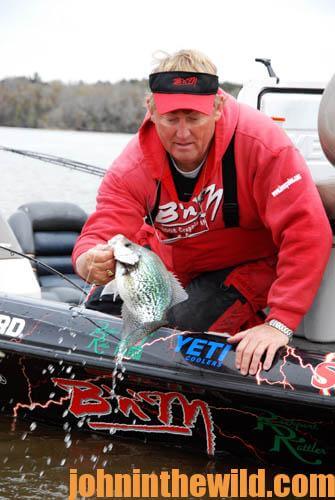 7) You may not be using the right equipment. The right equipment for me is the 14-foot B‘n’M pole. As far as I am concerned B‘n’M (www.bnmpoles.com) makes the only real crappie poles and rods on the market. I like the 14-foot pole because it allows me to get further away from the boat, so I spook fewer fish. The pole has enough backbone in it to allow me to fight really big fish, get them up from deep water and put them in the boat. In cold weather, I fish light line, little minnows and deep water. I depend on my electronics. If you don’t have the right equipment, then you can’t expect to catch as many crappie as the people do who have the correct equipment.
7) You may not be using the right equipment. The right equipment for me is the 14-foot B‘n’M pole. As far as I am concerned B‘n’M (www.bnmpoles.com) makes the only real crappie poles and rods on the market. I like the 14-foot pole because it allows me to get further away from the boat, so I spook fewer fish. The pole has enough backbone in it to allow me to fight really big fish, get them up from deep water and put them in the boat. In cold weather, I fish light line, little minnows and deep water. I depend on my electronics. If you don’t have the right equipment, then you can’t expect to catch as many crappie as the people do who have the correct equipment.
8) You aren’t using a map of the lake. A really-good crappie fisherman who knows how to catch crappie during the winter months lives with a lake map. This map allows you to quickly and easily identify river channels, creek channels, drop-offs and ledges. If you don’t know where the structure is that holds the crappie, you can’t catch them. If you find crappie for instance, on the edge of a drop-off, 16-feet deep in the lake, and those crappie quit biting, you need to know where there is another drop-off at 16-feet deep where you may locate another school of crappie on the day you are fishing. Crappie are patternable in the winter. When you establish a pattern, you need to know where you can run to other places in the lake and pinpoint that same type and that same depth of water. The lake map will give you that information. If you don’t have and use a lake map, you won’t find and catch as many crappie as the fishermen who do.
9) You don’t have or you’re not using your GPS (Global Positioning System). If I catch one or two nice fish on a place I am fishing, I quickly mark that location as a waypoint on my hand-held GPS receiver. Once I have that location marked, I’ll return to that same spot maybe two or three times during the day. That GPS spot that I’ve marked tells me where the crappie are. If I keep going back to where the school is located, at some time during the day, that school has to feed. So, if I fish that school two or three times during the day, I drastically have increased my odds of having my bait in front of the crappie at the time they want to feed. I promise you that the hand-held GPS receiver consistently will put more crappie in your boat than the fishermen who don’t have those or don’t use them often enough. Another advantage to using a GPS to mark spots where you catch crappie is that crappie have been in that location for a reason. There is something in that area that is holding fish. It may be a brush pile, a stump, a log, a niche in the bank, or it just may be a spot where bait fish for some unknown reason just like to hang out. But regardless of the reason, if you catch one crappie in that place, there is a very good chance that the next time you go back to that site there will be a crappie there again.
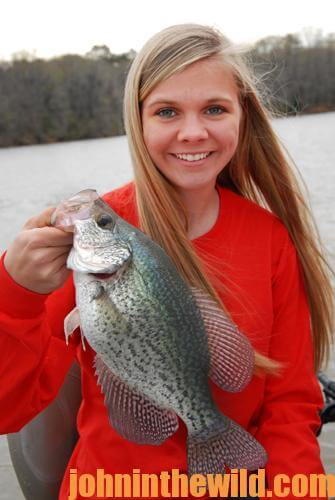 10) You’ve stayed with the deep water too long. During the winter months, although crappie historically hold in deep water, late in the afternoon when the water warms up, those fish often will move up out of that deep water on to the top of the ledge – in 8-10 foot of water. So, if you’ve caught crappie in 20- to 30-foot-deep water, and you don’t know to look for crappie in that 8- to 10-foot range later in the afternoon, you’re not going to catch crappie in the afternoon like you have in the morning. Be aware of the fact that when the sun is shining all day, the water will be warmer in the afternoon than it is in the morning. As that water warms up, the crappie will come up from the deep water to the shallow water. So, learn to look for them in more-shallow water in the afternoon than in the morning.
10) You’ve stayed with the deep water too long. During the winter months, although crappie historically hold in deep water, late in the afternoon when the water warms up, those fish often will move up out of that deep water on to the top of the ledge – in 8-10 foot of water. So, if you’ve caught crappie in 20- to 30-foot-deep water, and you don’t know to look for crappie in that 8- to 10-foot range later in the afternoon, you’re not going to catch crappie in the afternoon like you have in the morning. Be aware of the fact that when the sun is shining all day, the water will be warmer in the afternoon than it is in the morning. As that water warms up, the crappie will come up from the deep water to the shallow water. So, learn to look for them in more-shallow water in the afternoon than in the morning.
Bonus Tip: Don’t be afraid to put some color in the water. Many times in the winter, crappie want a little color with their minnows – a jig tipped with a minnow. Sometimes a little flash of color, some sparkle, a little glitter, and/or some chartreuse will make those crappie bite when they won’t bite a minnow with no color. So, if you’re not catching fish, start experimenting with jig-and-minnow combinations using different colors. Anything you can do to help the crappie see or smell your bait many times will be the difference in whether you do or don’t catch crappie.
Remember that crappie fishing is like coaching a football team. You have to run different plays to determine what is working. You may have to change your whole game plan and try something new or different to make those fish bite, once you locate them. But the crappie are in the water during the winter, they have to eat at some time during the day, and all you have to do to catch them is to be where they are, when they want to eat with a bait they will eat.
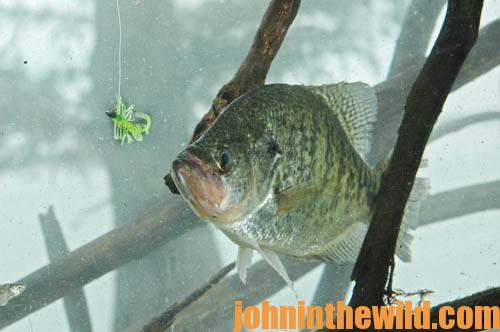 To learn much more about crappie fishing, get John E. Phillips’ Kindle eBooks, and print and Audible books by going to https://johninthewild.com/books/#crappie or to www.barnesandnoble.com for Nook books. To receive and download for free “The Crappie Catchers’ Cookbook,” by John and Denise Phillips, go to https://johninthewild.com/free-books.
To learn much more about crappie fishing, get John E. Phillips’ Kindle eBooks, and print and Audible books by going to https://johninthewild.com/books/#crappie or to www.barnesandnoble.com for Nook books. To receive and download for free “The Crappie Catchers’ Cookbook,” by John and Denise Phillips, go to https://johninthewild.com/free-books.

